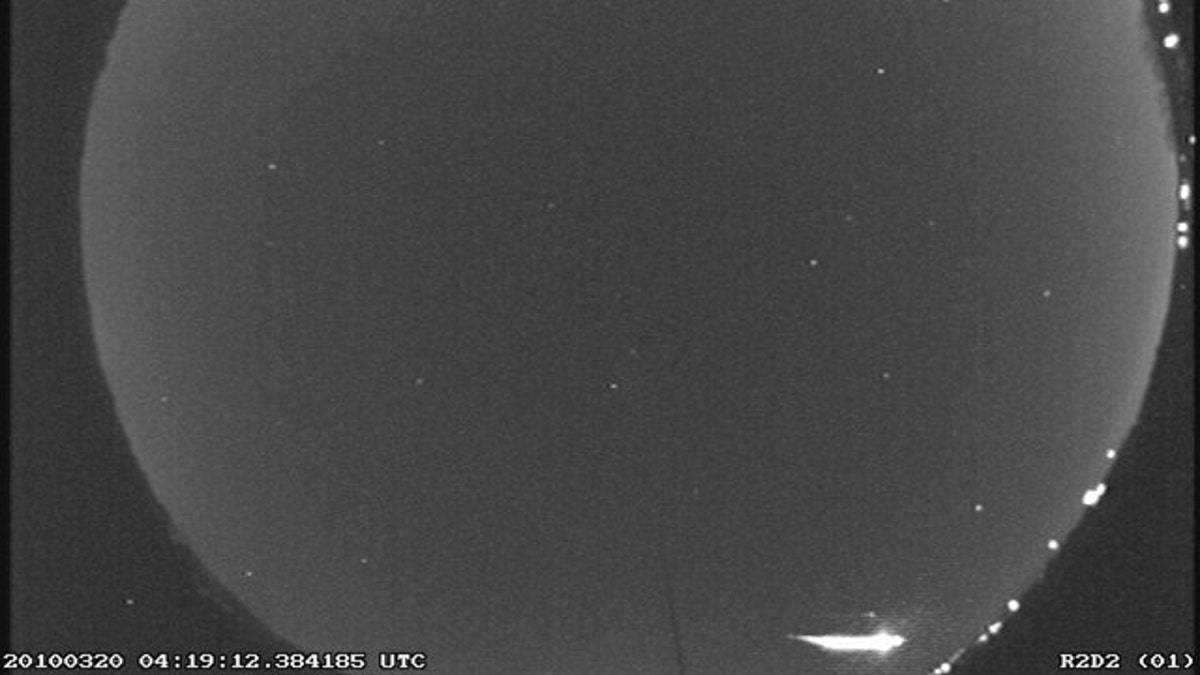
This photo is a still taken from a NASA Allsky camera video taken of a meteor fireball over western Alabama on March 19, 2010. The meteor was about the size of a soccer ball and completely incinerated before reaching the ground, scientists say. (NASA/Marshall Space Flight Center)
A bright fireball that lit up the sky above parts of Alabama last week was caught by NASA cameras as it streaked over the southeastern United States.
The fireball was caused by the death plunge of a meteor about the size of a soccer ball as it burned up in Earth's atmosphere on Friday, March 19, at 11:19 p.m. local time while flying over western Alabama. Two NASA cameras, one based at the agency's Marshall Space Flight Center in Huntsville, Ala., recorded a the meteor's fiery demise as it happened.
"At its brightest, it was brighter than the crescent moon," Bill Cooke, a meteor expert at the Marshall center, told SPACE.com in an e-mail. "This gives a mass of about 10 kilograms and a diameter of [about] 20 centimeters - a decent size!"
The meteor was first caught on film at an altitude of about 45.3 miles and burned up while it was still about 20 miles above the Earth [see more meteor photos]. The space rock was not big enough to result in a meteorite – that is a meteor that survives the scorching heat of entering Earth's atmosphere and hits the ground, sometimes carving out big holes in the planet.
The meteor was streaking across the sky at about 42,500 mph (that's 12 miles every second) when it was picked up an Allsky meteor-tracking camera at the Marshall Space Flight Center, as well as a similar camera in Chickamauga, Ga., that is also operated by the center.
Cooke said the two cameras allow scientists to compare different views of the same fireball in order to triangulate its path across the night sky. While there are other meteor-tracking networks across the United States, NASA's system at Marshall uses timestamps and global positioning satellite data to coordinate when fireballs are observed.
We have plans to deploy two more units to regional schools in the very near future, and then will extend the network into the mid-Atlantic states," Cooke said.
Fireballs like the one caught on film are relatively common, Cooke said. Most times, like Friday's event, the meteors put on a spectacular light show, but burn up before any piece can reach the ground.
Most of the events aren't seen by most people for several reasons, among them: Most meteors are visible only at night, when not as many people are outside; the majority fall over the ocean, since Earth is two-thirds covered by water. But for those who routinely go out and look up, and assuming clear skies away from urban light pollution, fireballs are not so rare.
"We see fireballs (meteors brighter than the planet Venus) almost every clear night," Cooke said. "Events like the one above are seen about once every couple months."
Copyright © 2010 Space.com. All Rights Reserved. This material may not be published, broadcast, rewritten or redistributed.
